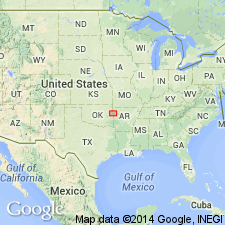
- Usage in publication:
-
- Brewer Bend Limestone Member*
- Modifications:
-
- Named
- Dominant lithology:
-
- Limestone
- Mudstone
- AAPG geologic province:
-
- Arkoma basin
- Chautauqua platform
Summary:
Named as the upper member of the Sausbee Formation (new). Type area designated on both sides of Arkansas River near Webbers Falls Reservoir, southeast Muskogee Co, OK. Source of geographic name not stated. Occurs in Muskogee and Cherokee Cos, OK, Chautauqua platform, and east in OK to Sequoyah and western Adair Cos, Arkoma basin. Facies changes occur eastward in Adair Co, and nomenclature applied to equivalent rocks changed to Hale Formation and lower part of Bloyd Shale. Names Hale and Bloyd were applied in earlier reports to rocks named Brewer Bend in this report. Overlies and intertongues with Braggs Member (new) of Sausbee. Unconformably underlies Chisum Quarry Member (new) of McCully Formation (new). Consists of algal thin- to medium-bedded, nodular, cliff-forming limestone (wackestone) and mudstone. Is thickest (12.6 m) to southwest part of outcrop. Thins to northeast to 1.2 to 3.7 m. Is a shoaled, widespread carbonate mudbank unit deposited in Early Pennsylvanian, early Morrowan time. Stratigraphic chart. Cross section.
Source: GNU records (USGS DDS-6; Denver GNULEX).
For more information, please contact Nancy Stamm, Geologic Names Committee Secretary.
Asterisk (*) indicates published by U.S. Geological Survey authors.
"No current usage" (†) implies that a name has been abandoned or has fallen into disuse. Former usage and, if known, replacement name given in parentheses ( ).
Slash (/) indicates name conflicts with nomenclatural guidelines (CSN, 1933; ACSN, 1961, 1970; NACSN, 1983, 2005, 2021). May be explained within brackets ([ ]).

